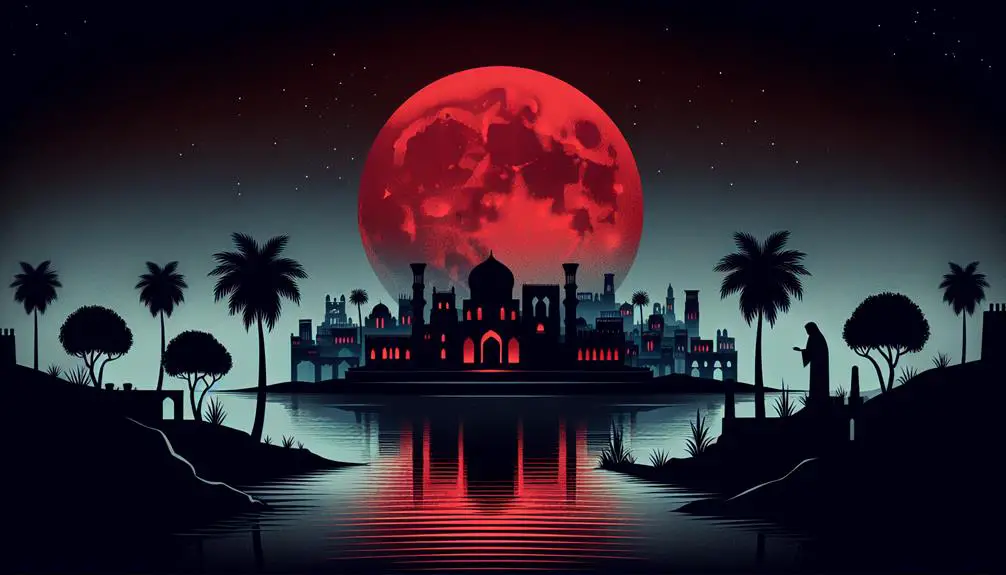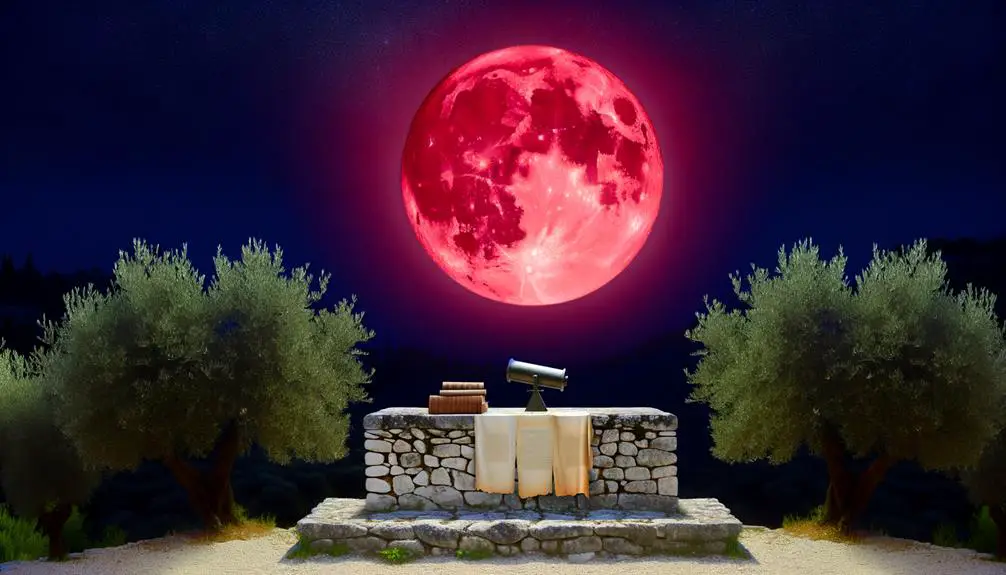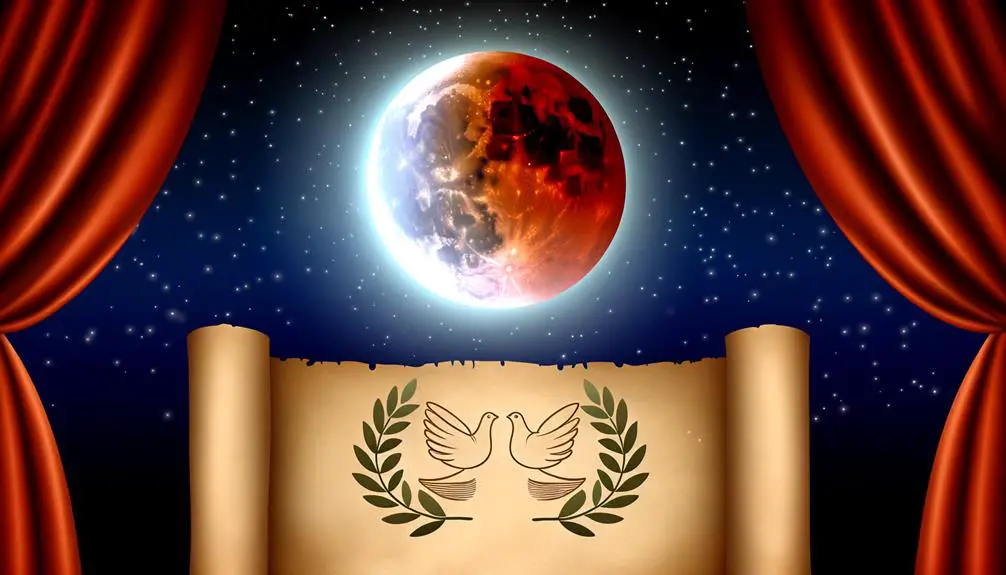Peer into the enigmatic allure of the Blood Moon in biblical prophecy, unveiling a tale of divine signs and apocalyptic wonders.

The Blood Moon in the Bible
Have you ever wondered why the Blood Moon holds such a mysterious allure in biblical texts? You're not alone. This celestial event, rich in historical and prophetic significance, has puzzled scholars and the faithful alike for centuries.
Biblical references to the Blood Moon are often shrouded in apocalyptic imagery, suggesting a time of profound change. As we explore its mentions in scripture, you'll find that the interpretations and theories surrounding this phenomenon are as varied as they are fascinating.
This journey into the past may just shed light on its modern implications, leaving you pondering its true impact on contemporary faith and society.
Key Takeaways
- Blood Moons are noted in biblical scriptures, including Joel 2:31, Acts 2:20, and Revelation 6:12, symbolizing significant spiritual or historical transitions.
- They hold prophetic and symbolic meanings within the biblical narrative, often interpreted as signs of divine messages or impending changes.
- Throughout history, Blood Moons have been viewed with deep religious significance, influencing theological discussions and interpretations.
- Contemporary biblical scholars debate the significance of Blood Moons, reflecting a range of interpretations from calamity to significant religious events.
The Phenomenon Explained

The Blood Moon, a captivating celestial event, occurs when the Earth positions itself between the Sun and the Moon, casting a reddish shadow on the latter due to the refraction of sunlight through the Earth's atmosphere. This phenomenon, deeply rooted in astronomical causes, primarily involves the mechanics of lunar eclipses. To comprehend the Blood Moon, you must first understand the intricacies of these eclipses.
Lunar eclipses transpire when the Moon moves into the Earth's shadow, an event that can only occur during a full moon when the Sun, Earth, and Moon align in a straight or nearly straight configuration. This alignment is categorized into two types: partial and total lunar eclipses. In a total lunar eclipse, the Earth entirely obstructs direct sunlight from reaching the Moon, with the only light appearing on the Moon's surface being refracted through the Earth's atmosphere. This refraction filters out the shorter blue wavelengths of light, allowing only the longer red wavelengths to reach and reflect off the Moon, thereby giving it a distinctive reddish hue that's often described as a Blood Moon.
The astronomical causes behind this event are precise and predictable, governed by the laws of celestial mechanics. The occurrence of lunar eclipses, and by extension Blood Moons, follows a well-documented cycle known as the Saros cycle, which spans approximately 18 years. This cycle allows astronomers to predict lunar eclipses with remarkable accuracy.
Understanding the Blood Moon through the lens of its astronomical causes not only demystifies the event but also highlights the predictable nature of celestial phenomena.
Historical Context

Throughout history, humans have observed Blood Moons, perceiving them through various cultural, religious, and scientific lenses, each interpretation shedding light on the era's understanding and beliefs. Ancient observances of these celestial events were often linked to omens or divine messages, reflecting a time when the heavens were closely watched for signs that might influence human affairs. Lunar celebrations, in particular, were common among early civilizations, where the Blood Moon could signify important seasonal changes or moments of spiritual significance.
The historical context of Blood Moons reveals a rich tapestry of human interaction with the cosmos. In many ancient societies, these events prompted rituals and ceremonies designed to appease gods or spirits believed to be influencing what was seen in the sky. Such practices underscore the profound impact astronomical phenomena had on the collective psyche of communities, guiding agricultural practices, and even warfare decisions.
Moreover, the scientific understanding of Blood Moons evolved over centuries. Initially shrouded in myth and superstition, the progression of astronomy allowed cultures to gradually demystify these occurrences. This shift didn't diminish their significance but rather enriched the collective knowledge about the natural world, fostering a deeper appreciation for the predictability and beauty of celestial events.
As you delve into the historical context of Blood Moons, you're invited to consider how these events have woven through the fabric of human history, marking moments of fear, reverence, and enlightenment. They serve as a reminder of humanity's enduring fascination with the universe and our continual quest to understand our place within it.
Biblical References

Shifting our focus to the pages of the Bible, we find that Blood Moons hold significant prophetic and symbolic meaning within its texts. The phenomenon of a Blood Moon, where the moon takes on a reddish tint during a lunar eclipse, has captivated the imagination of many, but it's within the biblical narrative that its significance is most deeply explored. This exploration reveals a rich tapestry of lunar symbolism and prophetic significance, deeply intertwined with the biblical worldview.
In the Bible, several references stand out, illustrating the importance of this celestial event:
- Joel 2:31: The prophet Joel speaks of a time when 'the sun will be turned to darkness and the moon to blood before the great and dreadful day of the Lord comes.' This reference is often interpreted as a sign of significant spiritual or historical changes.
- Acts 2:20: Echoing Joel, the book of Acts reiterates the phenomenon, signaling its importance in the context of New Testament prophecies and the establishment of the Christian Church.
- Revelation 6:12: In the Revelation to John, the Blood Moon appears as part of the opening of the sixth seal, symbolizing a time of judgment and radical transformation.
These references serve as focal points within the biblical narrative, where the Blood Moon isn't merely an astronomical event but carries deep prophetic significance. They underscore a worldview in which celestial phenomena are seen as signs, imbued with meaning beyond their physical appearance. The analytical exploration of these texts reveals a complex interplay between natural events and their symbolic resonance within a theological framework, underscoring the Bible's rich imagery and its interpretive depth.
Interpretations and Theories

Often, scholars and theologians debate various interpretations and theories surrounding the Blood Moon's biblical significance, aiming to unravel its prophetic messages. This discussion delves deep into lunar symbolism and prophetic debates, offering a nuanced perspective on its place within biblical narrative and eschatological expectations.
You'll find that lunar symbolism is rich within biblical texts, where the moon often represents cycles, change, and the passage of time. The Blood Moon's appearance is no exception, prompting diverse interpretations that range from signs of forthcoming calamity to markers of significant religious events. Scholars meticulously analyze scriptural passages, juxtaposing historical contexts with contemporary understanding to deduce the Blood Moon's role in biblical prophecy.
Prophetic debates further complicate these interpretations. Some theologians argue that the Blood Moon directly signals impending divine interventions or cataclysmic events that align with end-times prophecies. Others caution against such literal interpretations, suggesting instead that these celestial phenomena serve as metaphors for spiritual renewal or calamity depending on the moral state of humanity.
In dissecting these theories, it's crucial to approach with a critical yet open mind. The interplay between lunar symbolism and prophetic messaging in the Bible is intricate, reflecting broader theological discussions about divine communication and the interpretation of signs. As you navigate these debates, you're encouraged to consider the historical and cultural lenses through which these interpretations are made, recognizing the complexity and diversity of thought that surrounds the Blood Moon's biblical significance.
Modern Implications

As we explore the contemporary relevance of the Blood Moon, it's essential to consider how modern interpretations reflect evolving societal and religious contexts. The phenomenon of the Blood Moon, once a harbinger of ominous events in ancient texts, now garners attention for its aesthetic beauty and the cultural narratives it inspires. In today's world, the Blood Moon serves as a focal point for various modern implications, ranging from its role in cultural festivals to its influence on astronomical myths.
The transformation of the Blood Moon's significance is indicative of broader shifts in how societies engage with celestial events. This change can be observed in several key areas:
- Cultural Festivals: The Blood Moon often coincides with or is incorporated into cultural festivals around the world. These events celebrate the unique spectacle through art, music, and community gatherings, emphasizing the communal rather than apocalyptic aspects of the event.
- Astronomical Myths: Despite the scientific understanding of lunar eclipses, the Blood Moon continues to inspire modern myths and speculative theories. These narratives often blend scientific facts with speculative fiction, illustrating the human penchant for storytelling.
- Education and Public Engagement: The Blood Moon serves as an educational tool to engage the public with astronomy. Observatories, museums, and educational institutions often organize viewing parties and lectures to coincide with Blood Moon events, promoting scientific literacy and interest in space.
Frequently Asked Questions
How Have Different Cultures Outside of the Biblical Context Interpreted the Blood Moon?
You'll find that various cultures interpret the blood moon through the lens of lunar mythology, often seeing it as an omen or a sign from the gods.
These interpretations can significantly influence agricultural practices, as the appearance of a blood moon might dictate planting or harvesting times.
This connection between celestial events and farming underscores the profound impact that astronomical phenomena have had on human civilization, beyond religious or biblical understandings.
Can the Blood Moon Have Any Psychological Effects on Individuals, According to Studies or Reports?
You might wonder if the blood moon impacts your mind or behavior.
Studies in lunar psychology suggest it can affect sleep patterns, potentially disrupting your nightly rest.
Although concrete evidence linking the blood moon specifically to psychological effects is scant, the phenomenon of a full moon influencing human behavior has been explored.
Researchers continue to debate its significance, indicating that while the blood moon is visually striking, its psychological impact remains a topic of investigation.
What Are the Most Notable Artistic Representations of Blood Moons in Literature, Paintings, or Music Throughout History?
Just as werewolves transform under a full moon, artists have long been captivated by the Blood Moon, weaving its crimson hue into the fabric of culture.
From Shakespeare's Blood Moon sonnets to Beethoven's moonlit symphonies, these celestial events are more than mere skywatching spectacles; they're rich with Lunar symbolism.
Paintings, literature, and music throughout history have portrayed Blood Moons as harbingers of change, reflection, and deep emotional resonance.
How Do Contemporary Non-Religious Groups, Such as Secular Scientists or Amateur Astronomers, Participate in or Celebrate Blood Moon Events?
You'll find that contemporary non-religious groups, including secular scientists and amateur astronomers, eagerly engage in blood moon events.
They rely on telescope advancements to observe these celestial phenomena more closely and employ sophisticated photography techniques to capture stunning images.
This approach not only satisfies their curiosity but also contributes significantly to scientific research and public education about lunar events, devoid of any religious interpretations.
Are There Any Documented Instances Where the Prediction of a Blood Moon Significantly Influenced Political Decisions or Historical Events Outside of the Biblical Narrative?
You're asking if lunar eclipses, or 'blood moons,' have swayed political decisions or historical events, bypassing biblical associations. While astronomical predictions boast accuracy, documented instances intertwining lunar eclipses folklore with significant political moves are scarce.
Historically, these celestial events may have sparked fear or awe, but solid evidence linking them directly to pivotal political decisions isn't prominent. The impact seems more rooted in cultural interpretations than in direct influence on governance or historical outcomes.
Conclusion
In conclusion, the Blood Moon has traversed the sky of human imagination, casting shadows on the canvas of our collective consciousness. Like a celestial brushstroke, it has painted epochs with hues of prophecy and foreboding.
Your journey through the tapestry of its biblical significance reveals a complex interplay of divine signals and earthly interpretations. This astral phenomenon, a cosmic whisper, urges a scholarly vigilance to discern the threads of truth woven into the fabric of ancient texts and modern understandings.



Sign up